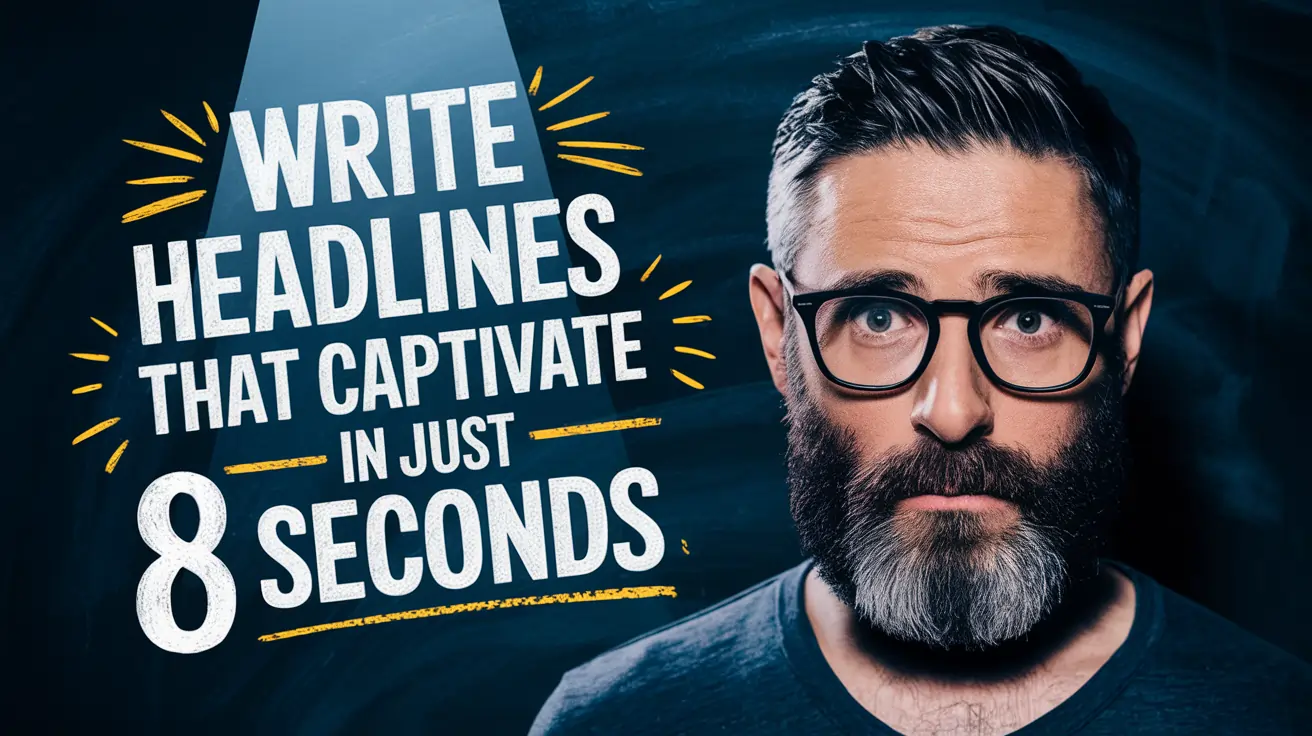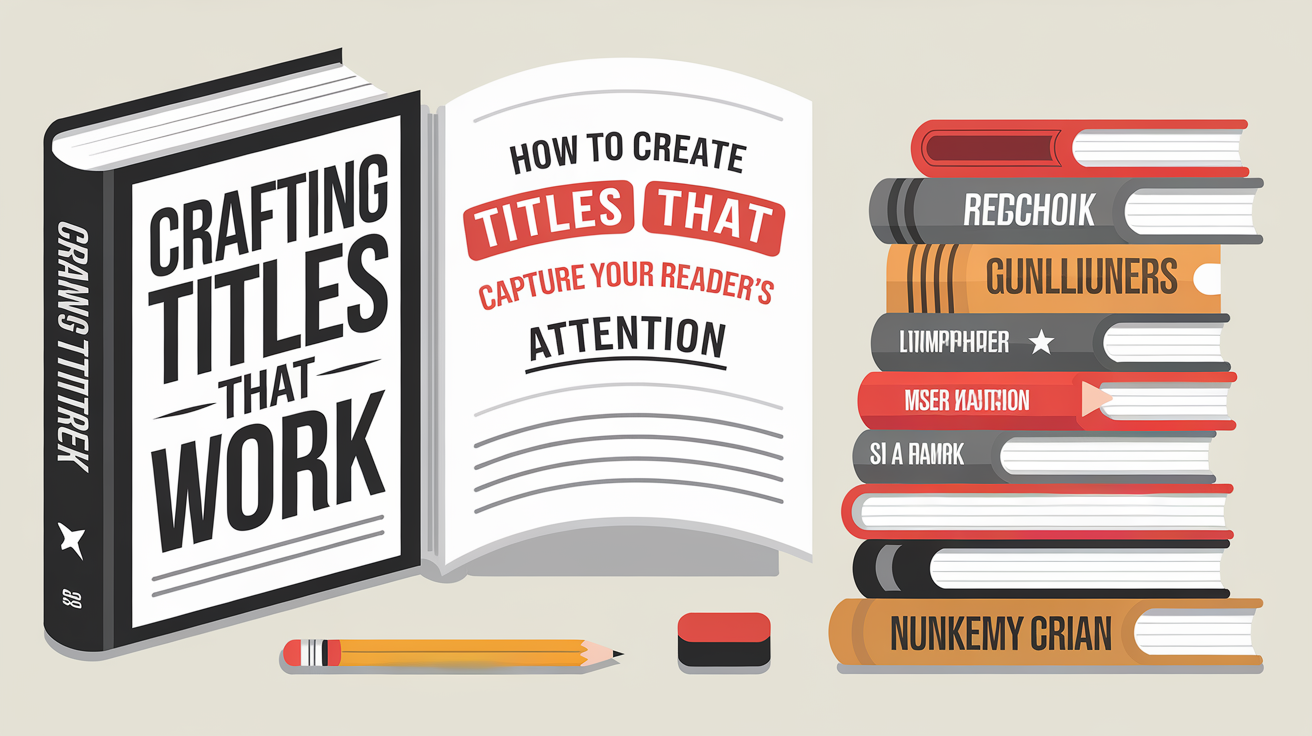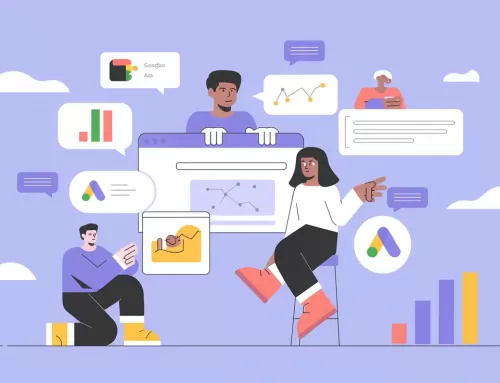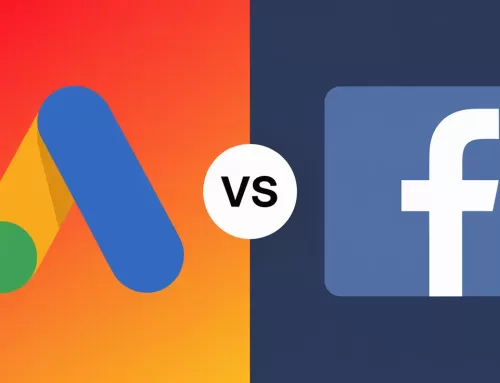
Why Headlines Matter
In a world where attention is a scarce resource, headlines are more important than ever. Whether you’re crafting a blog post, writing a sales email, or creating a social media caption, the headline is your first and often only chance to grab your audience’s attention. A powerful headline can mean the difference between content that gets noticed and content that gets ignored.
The 8-Second Rule
Did you know the average human attention span is now just 8 seconds? That’s shorter than a goldfish’s attention span of 9 seconds! This means you have a blink-and-you-miss-it opportunity to make an impression. Your headline must instantly communicate value, intrigue, or urgency to keep your audience from scrolling past.
Headlines: The Gateway to Engagement
The role of a headline goes beyond just grabbing attention. It sets expectations for the content and determines whether readers will invest their time in it. A compelling headline can:
- Capture Attention: Stop readers in their tracks.
- Spark Curiosity: Make them want to know more.
- Set Expectations: Tell them what they’ll gain by reading further.
- Drive Action: Increase clicks, shares, and even conversions.
For example:
- A weak headline like “Interesting Blog Post About Marketing” might leave readers unimpressed.
- A strong headline like “10 Proven Marketing Strategies That Double Your Sales” instantly sparks curiosity and conveys value.
Headlines in the Digital Era
In today’s digital landscape, headlines are the foundation of your content strategy. Platforms like Google and social media algorithms prioritize content with higher engagement rates, and your headline is what drives that engagement. Whether it’s for SEO purposes or catching someone’s eye on a crowded social media feed, a headline’s impact cannot be overstated.
Quick Tip: Headlines that are optimized with relevant keywords can boost search rankings, making them easier for your audience to find.
Setting the Stage for Success
Throughout this guide, we’ll explore the psychological principles behind effective headlines, actionable tips for crafting them, and tools to help you test and optimize your efforts. By the end, you’ll have everything you need to create headlines that not only captivate but also convert.
The Psychology Behind Headlines

Explore how psychological principles shape the way audiences respond to titles and how to use emotions, curiosity, and urgency to create impactful content.
To craft a headline that grabs attention and drives action, you need to understand the psychology behind what makes people click. Humans are emotional beings, driven by curiosity, urgency, and the desire for connection. The most successful headlines tap into these psychological triggers, compelling readers to engage.
Emotional Triggers
Humans make decisions based on emotions, even when they think they’re being rational. A headline that evokes strong emotions—such as excitement, fear, joy, or curiosity—can create an instant connection with readers. For example:
- Positive Emotion: “10 Life-Changing Morning Habits for a Happier You”
This appeals to joy and the desire for self-improvement. - Negative Emotion: “The 5 Deadly Mistakes You’re Making in Your Job Search”
Fear of failure compels readers to learn how to avoid these mistakes.
According to research from the Content Marketing Institute, emotionally charged headlines can increase click-through rates by up to 50%. Words like “essential,” “groundbreaking,” or “life-changing” tap into emotional states like pride, hope, or urgency.
Real-World Example:
Think about BuzzFeed’s famous listicles like, “21 Things Only Coffee Lovers Will Understand.” These types of headlines appeal to readers’ emotions by creating a sense of belonging and relatability.
Quick Tip: Use emotionally loaded words like “incredible,” “shocking,” or “ultimate” to make your headlines resonate on a deeper level.
Curiosity and Intrigue
Curiosity is one of the most powerful psychological forces. When we encounter a mystery or a question, we feel an irresistible need to find out more. This is known as the “curiosity gap”—the space between what we know and what we want to know.
Examples of curiosity-driven headlines include:
- “What You Don’t Know About Your Credit Score Could Cost You Thousands”
- “The One Secret Top Entrepreneurs Won’t Tell You”
Both headlines hint at valuable insights without giving away the full story. This approach lures readers to click, hoping to uncover the missing information.
Why It Works: Curiosity plays on our natural desire for closure. Headlines that spark questions make readers feel they’ll be incomplete without the answer.
Real-World Example:
Consider The New York Times’ headline, “How One Simple Trick Can Help You Sleep Better.” The intrigue lies in the phrase “simple trick,” making readers curious about what it might be.
Quick Tip: Use phrases like “The Secret to…” or “What You Need to Know About…” to create an air of intrigue.
Urgency
Urgency creates a sense of immediacy, pushing readers to act now rather than later. This psychological trigger works by tapping into the fear of missing out (FOMO), a powerful motivator in today’s fast-paced digital world.
Examples of urgency-driven headlines include:
- “Sale Ends Tonight: Grab 50% Off Your Favorites Now!”
- “Breaking: Major Weather Warning Issued for the East Coast”
Both headlines use time-sensitive language to create pressure, encouraging readers to act quickly. Urgency is especially effective in marketing campaigns and news updates where timely action is critical.
Real-World Example:
E-commerce websites frequently use urgency in their headlines. For example, Amazon’s “Today Only: Deals of the Day” taps into FOMO, ensuring customers feel compelled to check out the deals before they’re gone.
Quick Tip: Use action-oriented phrases like “Don’t Miss Out,” “Act Now,” or “Limited Time Only” to heighten urgency.
Summary of Psychological Triggers
- Emotional Triggers: Tap into joy, fear, pride, or pain to connect on a deeper level.
- Curiosity: Leave enough mystery to spark questions and drive clicks.
- Urgency: Push readers to act by emphasizing time-sensitive opportunities.
When combined, these psychological triggers create a powerful formula for headlines that captivate and convert.
Best Practices for Writing Headlines
Crafting a headline is both an art and a science. While understanding the psychology of your audience is crucial, following practical guidelines can elevate your headlines from good to exceptional. Here are the top best practices to make your headlines irresistible.
Keep It Short and Sweet
In the digital world, brevity is essential. A headline must be concise enough to grab attention but still communicate value. Most people scan content quickly, so overly long headlines risk being overlooked. For SEO, it’s also critical to keep headlines under 60 characters to ensure they display fully in search engine results.
Why It Works:
Short headlines are easy to read and process. They also fit better on social media platforms, making them more shareable.
Examples:
- “5 Tips for Better Productivity” (Short, clear, actionable)
- “How to Write Headlines That Convert” (Direct and impactful)
Practical Tip:
When writing a headline, strip away unnecessary words. For instance:
- Too Long: “Here Are Some Incredible Productivity Hacks You Should Try Today”
- Shortened: “Incredible Productivity Hacks to Try Today”
Tool to Try:
Use a headline analyzer like CoSchedule to evaluate the length and effectiveness of your headline.
Use Numbers and Lists
Headlines with numbers and lists perform exceptionally well. Why? Numbers give readers a clear idea of what to expect, creating a sense of order and predictability. Lists also make content appear more digestible and actionable.
Why It Works:
Our brains are naturally drawn to structure. Headlines with numbers promise specific insights, making them irresistible to readers.
Examples:
- “10 Essential Steps to Launching Your First Website”
- “7 Reasons Conversational Marketing is the Future of Business”
Interesting Fact:
Odd numbers, such as 3, 7, and 9, tend to perform better than even numbers. According to a study by Content Marketing Institute, odd-numbered listicles generate 20% more clicks.
Practical Tip:
For SEO, use numbers that match your audience’s search behavior. For example, if people search for “top 5 tools for web design,” make sure your headline aligns with that phrase.
Learn more about building effective websites in 10 Essential Tips for Building a Website for Startups.
Optimize with Keywords
Keywords are the backbone of SEO, ensuring your content is visible to the right audience. When crafting a headline, strategically incorporate your primary keyword without compromising readability. A well-optimized headline boosts your chances of ranking higher on search engines and attracting organic traffic.
Why It Works:
Search engines prioritize relevant, keyword-rich headlines, helping your content appear when users search for related topics.
Examples:
- Primary Keyword: Headlines
Optimized Headline: “Headlines That Convert: 10 Proven Strategies for Success” - Primary Keyword: Website design
Optimized Headline: “How to Choose the Best Website Design Agency for Your Brand”
Practical Tip:
- Use tools like Google Keyword Planner or Ubersuggest to identify popular search terms.
- Place your primary keyword toward the beginning of the headline for maximum impact.
Quick Exercise:
Compare these two headlines:
- Non-optimized: “Tips for Writing Headlines”
- Optimized: “10 Tips for Writing Headlines That Boost Engagement”
Notice how the second example is more targeted and actionable.
If you’re looking to refine your branding alongside headlines, check out Why Brand Identity and Brand Guidelines Matter for Success.
Test and Iterate
Even the best writers can’t predict which headline will perform best without testing. A/B testing is a proven method to compare different headline variations and determine which one resonates most with your audience.
Why It Works:
Testing takes the guesswork out of headline creation. It uses real audience data to identify the most effective version.
Examples of A/B Tests:
- Headline A: “How to Build a Successful Startup Website”
- Headline B: “10 Steps to Launching a Startup Website That Thrives”
Through A/B testing, you might discover that the second headline outperforms the first by 30%, providing valuable insight for future content.
Tools for Testing:
- Crazy Egg: Offers A/B testing features to compare headline variations.
- Google Optimize: Allows you to run experiments on your website.
Practical Tip:
Use polls on social media platforms like Instagram or Twitter to gauge audience reactions to potential headlines. Ask your followers which headline they find more engaging.
Example Post:
“Which headline grabs your attention? A) ‘Top 5 Design Trends for 2024’ or B) ‘The Hottest Design Trends You Need in 2024’ Vote below!”
Summary of Best Practices:
- Short and Sweet: Aim for under 60 characters and eliminate fluff.
- Numbers and Lists: Use odd numbers and actionable phrases to intrigue readers.
- Keyword Optimization: Strategically place primary keywords without overloading.
- Test and Iterate: Use data-driven insights to refine your headlines over time.
By combining these practices with creativity and strategy, you’ll consistently create headlines that captivate and convert.
Tools for Crafting and Testing Headlines

A visual metaphor for building compelling headlines, showcasing a toolbox with essential tools to symbolize the strategies needed for success.
In the competitive digital landscape, writing a great headline isn’t enough—you need tools to craft, analyze, and test them to perfection. The right tools can help you refine your headlines, ensure they resonate with your audience, and boost overall engagement. Let’s dive into some of the best tools for headline creation and testing.
1. Crazy Egg: A/B Testing for Headlines
Crazy Egg is a powerful tool that helps you test different versions of your headlines to see which one performs best. Its A/B testing feature allows you to compare two or more variations of your headline and track how each impacts clicks and conversions. This data-driven approach ensures that you’re using a headline optimized for your audience.
Why Use Crazy Egg?
- It provides heatmaps to visualize where users are clicking on your page.
- It offers detailed insights into user behavior, helping you understand why one headline outperforms another.
Quick Tip:
Test headlines with slight variations, such as:
- Version A: “5 Ways to Skyrocket Your Website Traffic”
- Version B: “Skyrocket Your Website Traffic in 5 Simple Steps”
Crazy Egg will show you which version drives more engagement.
2. CoSchedule Headline Analyzer
CoSchedule’s Headline Analyzer is a must-have tool for evaluating the quality of your headlines. It scores your headline based on factors like emotional appeal, word balance, and overall structure. The tool also provides suggestions to make your headline more engaging and impactful.
Why Use CoSchedule?
- It evaluates emotional and power words in your headline.
- It checks for length and readability, ensuring your headline is both concise and captivating.
- It offers tips to balance emotional, common, and uncommon words for maximum appeal.
Example:
If your original headline is “How to Write Headlines,” CoSchedule might suggest adding a number or emotional trigger to make it stronger, such as “10 Proven Tips for Writing Headlines That Convert.”
Try CoSchedule’s Headline Analyzer here.
3. AnswerThePublic: Headline Inspiration
AnswerThePublic is a tool that generates questions and phrases related to your chosen keyword, helping you brainstorm attention-grabbing headlines. It provides a visual map of commonly asked questions, giving you a peek into what your audience is curious about.
Why Use AnswerThePublic?
- It helps you identify topics and phrases your audience is actively searching for.
- It sparks creativity by showcasing unique angles for your headlines.
Example:
For the keyword “headlines,” you might see questions like:
- “What makes a good headline?”
- “How do headlines affect SEO?”
Inspiration from these questions can lead to headlines like:
- “What Makes Headlines Stand Out in a Crowded Market?”
- “Headlines and SEO: How to Drive Traffic and Rank Higher.”
4. BuzzSumo: Research Trending Headlines
BuzzSumo analyzes trending content and shows you which headlines are performing well in your niche. By studying these trends, you can craft headlines that resonate with your audience while staying relevant to current interests.
Why Use BuzzSumo?
- It reveals the most-shared articles on social media, helping you identify successful headline styles.
- It provides competitive insights by showing you what’s working for your competitors.
Example:
If a trending article headline is “5 Ways to Improve Remote Work Productivity,” you can adapt it to your niche, such as “5 Productivity Hacks for Startup Teams Working Remotely.”
Bringing It All Together
By combining tools like Crazy Egg, CoSchedule, AnswerThePublic, and BuzzSumo, you can approach headline creation strategically. Use these tools to brainstorm, refine, and test your headlines, ensuring they not only grab attention but also drive meaningful engagement.
Case Studies: Content Titles That Captivated Millions
Great content starts with a compelling title, and some of the most successful examples from around the web provide valuable lessons. Here, we’ll explore how different approaches to crafting titles have led to massive engagement. These examples show how creativity, psychology, and strategy come together to grab attention and drive action.
Case Study 1: Buzzfeed’s Listicles – “21 Things Only Coffee Lovers Will Understand”
Buzzfeed built its brand by mastering the art of creating shareable, engaging content. Titles like “21 Things Only Coffee Lovers Will Understand” resonate deeply because they:
- Appeal to a specific audience (coffee lovers).
- Promise relatability and humor, which trigger emotional connections.
- Use an odd number to stand out and intrigue readers.
Why It Worked:
This title creates a sense of belonging. Coffee enthusiasts feel seen and understood, motivating them to click and share with like-minded people. It’s also short, conversational, and easy to skim.
Case Study 2: The New York Times – “Coronavirus Updates: What We Know So Far”
During the pandemic, millions turned to trusted sources for reliable information. The New York Times’ title “Coronavirus Updates: What We Know So Far” drew massive attention by:
- Emphasizing timeliness and relevance.
- Offering a concise summary of valuable insights.
- Leveraging curiosity about the latest developments.
Why It Worked:
The combination of urgency and authority made this title highly effective. Readers trusted the source and wanted the most current information in an uncertain time.
Case Study 3: HubSpot Blog – “How to Write a Blog Post: A Step-by-Step Guide”
HubSpot’s educational titles have become a benchmark for content marketing. The title “How to Write a Blog Post: A Step-by-Step Guide” performed exceptionally well by:
- Addressing a common pain point among their target audience (blogging struggles).
- Providing a clear and actionable promise (a step-by-step guide).
- Using approachable and simple language.
Why It Worked:
It directly addressed the needs of content creators, offering value and expertise in a digestible format.
Case Study 4: Airbnb’s Email Campaign – “You’ve Got a $50 Credit Waiting for You”
Airbnb excels at crafting personalized emails, and this title is a standout example. It grabs attention by:
- Offering immediate value (a $50 credit).
- Using personalization (“you’ve got”) to create a one-on-one connection.
- Adding urgency with “waiting for you.”
Why It Worked:
The promise of free credit is hard to ignore, especially when framed as a personal reward. It taps into FOMO (fear of missing out), ensuring the recipient takes action quickly.
Case Study 5: LinkedIn Learning – “Upskill Today: 5 Courses to Boost Your Career”
LinkedIn Learning drives engagement by focusing on professional growth. This title effectively:
- Uses action-oriented language (“Upskill Today”) to motivate readers.
- Provides a specific benefit (boosting your career).
- Highlights value by showcasing a manageable number of courses.
Why It Worked:
This title appeals to professionals looking for quick, actionable solutions to enhance their skills. The immediacy of “today” encourages action without delay.
Lessons Learned from These Case Studies
- Tap into Emotions: Titles that resonate emotionally, whether through humor, urgency, or inspiration, are more likely to connect with readers.
- Be Specific: Include details that clearly explain the benefit of engaging with the content.
- Offer Value: Titles that promise practical, actionable insights often outperform generic ones.
- Create Urgency: Adding phrases like “today,” “limited time,” or “now” can drive faster responses.
Each of these examples demonstrates how well-thought-out titles can amplify content visibility and engagement, proving that investing time in crafting them is well worth the effort.
SEO and Titles: Boosting Search Visibility
Search engine optimization (SEO) is a cornerstone of digital content success, and your titles are a crucial part of that strategy. A well-optimized title improves your chances of ranking high on search engine results pages (SERPs), increasing your content’s visibility and driving organic traffic. Let’s break down how to leverage SEO effectively when crafting titles.
The Role of Titles in SEO
Search engines like Google use titles to determine the relevance of your content to a user’s query. A title that includes the right keywords and matches user intent signals to the algorithm that your content is valuable. Optimized titles not only improve rankings but also encourage clicks, as users are drawn to clear and relevant results.
Step 1: Conduct Keyword Research
Before crafting a title, start with solid keyword research. Keywords are the terms your target audience is actively searching for, and incorporating them strategically ensures your content appears in relevant search results.
How to Conduct Keyword Research:
- Identify Your Topic: Define the main theme of your content.
- Use Keyword Tools: Tools like Google Keyword Planner, SEMrush, or Ubersuggest can help you discover high-volume and low-competition keywords.
- Focus on Long-Tail Keywords: These are specific phrases like “how to improve website traffic” that often have less competition and higher conversion potential.
- Analyze Competitors: Review the titles of top-ranking pages in your niche. Identify the keywords they use and how they structure their titles.
Example:
For an article about improving website performance, potential keywords might include:
- Website optimization
- Increase website speed
- Boost website traffic
Step 2: Integrate Keywords Naturally
Once you have your keywords, the next step is to weave them seamlessly into your title. Keyword stuffing—forcing too many keywords into a title—can harm readability and reduce click-through rates. Instead, focus on making the title sound natural while keeping your primary keyword near the beginning.
Best Practices for Keyword Integration:
- Place the main keyword early in the title for better visibility in search results.
- Avoid repetition or awkward phrasing.
- Use supporting words to create a complete, engaging thought.
Examples:
- Keyword: “website design agency”
Optimized Title: “How to Choose the Best Website Design Agency for Your Brand” - Keyword: “content marketing tips”
Optimized Title: “10 Content Marketing Tips to Drive Engagement in 2024”
For guidance on building a professional online presence, check out How to Make Your Own Website Fast and Hassle-Free.
Step 3: Match User Intent
Search engines prioritize content that matches user intent. If someone searches for “how to create a startup website,” they likely want actionable steps, not a history of web design. Your title should clearly signal the value your content provides.
Matching User Intent in Titles:
- Informational Intent: “What Is Conversational Marketing? A Beginner’s Guide”
- Commercial Intent: “Top 5 Tools for Building an E-commerce Website”
- Transactional Intent: “Get 50% Off Website Development Services Today”
Understanding your audience’s needs ensures your title aligns with their expectations.
Step 4: Emphasize Clickability
A title optimized for SEO needs to appeal to both search engines and human readers. Adding emotional triggers, urgency, or curiosity can increase click-through rates, which indirectly improves SEO performance.
Examples:
- With Curiosity: “The Truth About SEO No One Talks About”
- With Urgency: “Don’t Miss These SEO Strategies for 2024 Success”
Step 5: Monitor Performance and Refine
SEO is not a one-time effort. Regularly analyze how your titles are performing and adjust as needed. Tools like Google Search Console can provide insights into impressions, clicks, and average position for each page.
Key Metrics to Track:
- Click-through rate (CTR): Are users clicking on your title in search results?
- Bounce rate: Are users staying on your page after clicking?
- Search rankings: Are your pages climbing in the SERPs?
By continuously refining your titles based on data, you can improve both search visibility and user engagement.
Final Thoughts
A well-optimized title bridges the gap between content and audience, ensuring your work gets the attention it deserves. By conducting thorough keyword research, matching user intent, and creating clickable, engaging titles, you’ll maximize the impact of your SEO efforts.
Quick Tip: Pair SEO-friendly titles with strong meta descriptions for even greater visibility. Together, they form the first impression your audience has of your content.
Putting It All Together: Crafting Titles That Work

An illustrated guide to creating impactful titles, featuring a stack of books and insights on engaging readers with compelling and strategic wording.
Creating an impactful title requires a combination of strategy, creativity, and continuous refinement. By implementing the insights shared throughout this guide, you’ll have the tools to craft titles that capture attention, spark curiosity, and drive engagement. Here’s a concise summary of actionable tips to help you master the process.
Actionable Tips for Crafting Effective Titles
- Understand Your Audience:
- Know your audience’s needs, emotions, and motivations.
- Tailor your titles to address their pain points or aspirations.
- Leverage Psychological Triggers:
- Tap into emotions like joy, fear, or curiosity to create a connection.
- Add urgency to encourage immediate action.
- Follow Best Practices:
- Keep it concise: Aim for under 60 characters for clarity and visibility.
- Use numbers and lists: Structured formats promise value.
- Optimize for SEO: Include primary keywords naturally, especially near the beginning.
- Test and Iterate:
- Experiment with different title variations using A/B testing tools like Crazy Egg.
- Use data from Google Analytics or Search Console to refine your approach.
- Engage your audience on social media by polling them on title preferences.
- Monitor Performance:
- Track click-through rates, bounce rates, and search rankings to measure success.
- Adjust your strategy based on performance data for continuous improvement.
Why Feedback and Testing Matter
No matter how much effort you put into crafting titles, testing and feedback remain crucial. A/B testing allows you to compare variations and make data-driven decisions. Similarly, audience feedback—whether through social media polls or user behavior analytics—provides insights into what resonates most.
For example:
- Test variations like “10 Marketing Tips for Beginners” vs. “Essential Marketing Tips You Can’t Ignore.”
- Track which version generates higher engagement and use that insight for future content.
Final Thought
Great titles are the gateway to successful content. By combining psychological principles, best practices, and iterative testing, you can create titles that don’t just grab attention—they deliver results. Start testing, stay adaptable, and watch your content performance soar.
Conclusion: Transforming Your Content Strategy
Crafting effective titles is more than just an art—it’s a strategy that can redefine your content’s impact. A well-thought-out title acts as a bridge between your audience’s curiosity and the value your content delivers. By applying the insights shared in this guide, you can transform your titles from an afterthought into a powerful tool for engagement and conversion.
Key Takeaways
- Understand the Power of Psychology:
Titles that tap into emotional triggers, spark curiosity, or create urgency are more likely to grab attention. These psychological principles ensure your content resonates on a deeper level. - Implement Proven Best Practices:
- Keep titles concise and actionable.
- Use numbers and lists to create structure and intrigue.
- Optimize titles with relevant keywords for better search visibility.
- Test, Learn, and Improve:
Testing variations and gathering feedback are crucial for success. Tools like Crazy Egg and CoSchedule help you refine your approach, ensuring your titles perform their best. - Leverage SEO for Visibility:
Use keyword research and align titles with user intent to boost your content’s discoverability. SEO-optimized titles not only increase clicks but also build long-term traffic.
Are you ready to elevate your content strategy? Start by exploring tools like AnswerThePublic or testing your current titles with Crazy Egg.
Your journey to mastering titles begins now. Experiment, refine, and watch as your content captivates, converts, and leaves a lasting impression.









Hello.
This post was created
Good luck :)